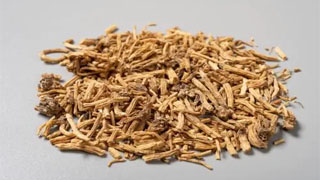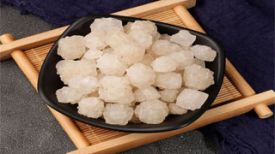
Nickname: Northeast Gentiana
Harvesting and processing: Harvesting and excavating in spring and autumn, with better quality harvested in mid to late October. Select larger ones, remove stems and leaves, wash, and dry. Small ones can be used for planting roots.
Medicinal parts: roots and rhizomes
Origin: Northeast China, Hebei, Shanxi
Subject: Gentianaceae
Original plant: Gentiana lanceolata
Plant condition: Perennial herb
Leaves thick, nearly leathery, sessile, upper leaves linear lanceolate to linear, base blunt, edges slightly rolled outward.
1-2 flowers; Calyx lobes linear lanceolate, longer or equal to calyx tube; The tips of the corolla lobes gradually become pointed.
Characteristics of Gentiana scabra slices: The rhizomes are mostly straight, blocky or elongated, measuring 0.5-1.5cm in length and 4-7mm in diameter. There are 2-16 clustered roots below, often less than 10. The root length is about 15cm and the diameter is 2-4mm; The surface is yellow brown or gray brown, with twisted longitudinal wrinkles, obvious fine horizontal stripes on the upper part, and a few raised root marks.
Gentiana medicinal properties:
The top-grade gentian in this sutra has a bitter and cold taste. It mainly affects the cold and heat between bones, startles epilepsy and evil qi, continues to eliminate injuries, regulates the Five Zangs, and kills Gu poison. It can be used for a long time to enhance intelligence and endurance, and is light and durable. It is suitable for tomb tours
Bitter taste, great cold, enters the Jueyin liver and Shaoyang gallbladder meridians of the feet. Clear the liver and reduce fever, cool the gallbladder and relieve fire.
Gentiana scabra is bitter cold and releases fire. It can relieve liver and gallbladder stagnation and heat, treat eye pain, redness, swelling, and high blood stasis. It can also treat jaundice, bladder heat and astringency, and relieve symptoms such as sore throat. Do not take it for those with moderate cold.
【 Origin 】 Perennial grass that grows naturally in the mountains and fields. Its leaves do not wither after frost and snow, and its roots are dark brown and used as medicine. [Taste] Sweet and astringent in taste, cold in nature, non-toxic.
【 Indications 】 Gentiana scabra is a medicinal herb for dispelling evil fire and removing dampness and heat. Its functions include strengthening the stomach, clearing heat, treating dysentery, and killing insects. It is also used for treating liver fire, gallbladder fire, stomach fire, and damp heat in the lower burner.
[Additional Record] Removing stomach heat, when the qi is warm, diarrhea caused by heat release, removing small insects in the intestines, nourishing the liver and gallbladder qi, and stopping anxiety. Zhen Quan treats children with strong heat, bone steaming, seizures entering the heart, temporary illnesses such as hot jaundice, and dry mouth. In the Great Ming Dynasty, the customer was dissatisfied with the qi of the chancre, overheated, and treated scabies by improving eyesight and quenching thirst.
[Element] Remove the yellow and red swelling in the eyes, raise blood stasis, and cause unbearable pain. 【 Dongyuan 】 Relieve the pathogenic heat in the liver meridian, remove the swelling caused by damp heat in the lower burner, and relieve the fire in the bladder.
Rongchuan has a bitter and astringent taste, combined with the properties of water and fire, which can relieve the fire in the liver and gallbladder. And the root of Gentiana scabra is abundant and deep, so it can relieve fire and reduce benefits, clearing heat to benefit the Shaoyang Sanjiao and gallbladder fire. Ni's note: Remove dampness and heat from the liver, gallbladder, spleen, and stomach in the middle burner. [Spiritual fetus] Relieve liver and gallbladder fire.
[Dosage] Normal five minutes to half a dollar.
【 Taboos 】 Avoid stomach deficiency and blood deficiency, diarrhea caused by spleen and stomach deficiency, and heat caused by disease deficiency.
Gentiana scabra is known for its bitter and cold nature, and it is effective in treating various damp and hot diseases. In ancient times, it was said that its ability to descend is the same as its ability to defend itself. When soaked in alcohol, it can ascend to the outer layer. Bupleurum chinense is the main herb used in Gentiana scabra, and it is essential for treating eye diseases. Due to severe cold, it should not be taken for a long time as it may harm stomach qi.
[Processing] Remove impurities, wash the mud and sand, remove, drain, let it sit, remove residual stems, cut 0.5-1 cm, sun dry or bake, and remove the ash to obtain. "
After harvesting, remove the stems and leaves, wash thoroughly, and dry in the sun.
【 Taste 】 Bitter; Sexual coldness
[Guijing] Liver; Gallbladder meridian
【 Indications 】 Clearing heat and dampness; Clearing the liver and calming the nerves. Primary damp heat jaundice; Painful urination; Yin swelling and itching; Under the humid and hot zone; Head swelling and headache caused by liver and gallbladder fire; Red and swollen eyes; Deaf ear swelling; Pain in the abdomen and mouth; Fever, wind, convulsions
[Usage and Dosage] Oral administration: decoction, 3-6g; Or into pills or powder. External use: appropriate amount, decoct and wash with water; Or apply it after grinding.
【 Attention 】 Patients with weak spleen and stomach who experience diarrhea or lack of damp heat and solid fire should avoid taking it on an empty stomach. "


